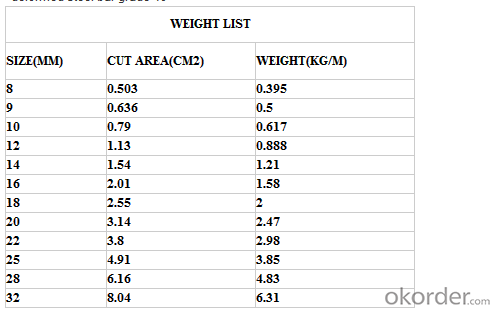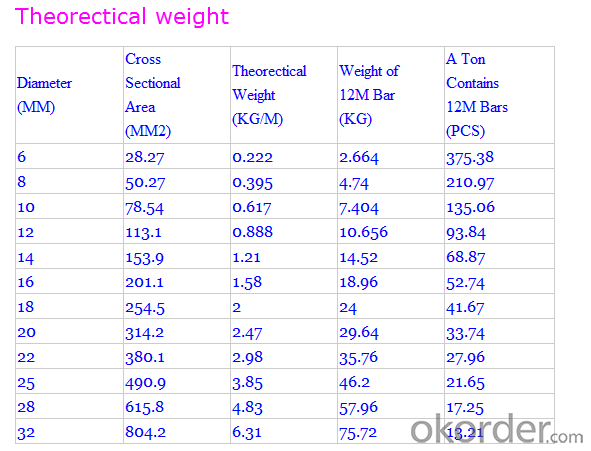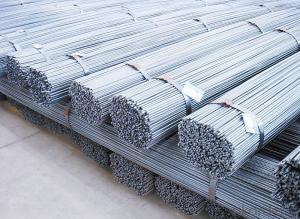Favorites Compare Steel Rebar, Deformed Steel Bar, Iron Rods For Construction
- Loading Port:
- Shanghai
- Payment Terms:
- TT OR LC
- Min Order Qty:
- 100 m.t.
- Supply Capability:
- 1000 m.t./month
OKorder Service Pledge
OKorder Financial Service
You Might Also Like
deformed steel bar grade 40
material: HRB400, BS4449 GR460B
size: 8-36mmx12m.
short delivery time by bulk or container
deformed steel bar grade 40
material: HRB400, BS4449 GR460B
size: 8-36mmx12m.
short delivery time with bulk or container
packing: Mill standard export packing in bundles/coil, around 2tons/bundle.
country of Origin: China
delivery Time: Within a 35 days
Shipment: by bulk vessel or by container

Leading goods:
section steel:angles,channels,I-beam,H-beam;
coils:cold/hot rolled coils,PPGI,galvanized coils,plate,checkered plate,cutting steel plate,steel strip;
wire rod:steel wire,deformed wire,bar;
pipe:seamless pipe,rectangular pipe,welded pipe,spiral welded pipe,pipe fittings;
stainless steel:steel sheets,stainless steel strips,stainless bar,stainless tube;
special:weathering steel,shipbuilding steel;
construction steel:C-channel,Z-channel,T-bar,high-speed divider plate,corrugated steel plate,steel grating.
Advantage:
We are the spot supplier, Six huge warehouses which can hold 20,000 MT goods.
It makes the cost lower than others,we can provide the competitive price for you.
Delivery time:
Normal sizes can be provided in 7days, the others should be ready in 30---45 days.
Further treatment:
We can offer cutting,painting,drilling holes,bending,threading, welding,galvanization,packing etc.
Security interest:
We have already passed the ISO9001, BV and SGS authentication which makes the quality secured.
If you have the interest in any of the products we can provided, pls don't hesitate to connect with me. Looking forward to cooperate with you.

FAQ of Steel Deformed Bar
1. More than 10 years experience in this industry
2. 100,000 tons exporting per month
3. Professional foreign trade tea
4. OEM&ODM capacity
5. High quality assured & competitive price
6. Try our best to meet your needs & save your budget
7. Very popular in Southeast Asia, Africa, Mid-East and South America etc.
8. VIP membership system, first time customers and long-term cooperation customers can get extra discount on some products.
- Q:How do steel rebars affect the overall thermal stability of a structure?
- Steel rebars can significantly improve the overall thermal stability of a structure. Due to their high thermal conductivity, steel rebars help in dissipating heat more efficiently and evenly throughout the structure. This prevents the formation of localized hot spots and reduces the risk of thermal expansion, which can cause structural deformations and cracks. Additionally, steel rebars enhance the structural integrity of a building during fire incidents by providing necessary reinforcement and preventing sudden collapses.
- Q:Can steel rebars be used in structures with high levels of carbonation or acid attack?
- Structures with high levels of carbonation or acid attack should avoid using steel rebars. Carbonation occurs when alkaline compounds in concrete react with carbon dioxide from the atmosphere, resulting in a decrease in the concrete's pH level. This can cause the corrosion of steel rebars, as the lower pH levels create an acidic environment that promotes rusting. Similarly, acid attack happens when structures come into contact with acidic substances like industrial chemicals or acid rain. Acidic environments accelerate the corrosion process by further lowering the pH levels of the concrete, increasing the risk of steel rebar deterioration. To prevent these problems, structures exposed to high levels of carbonation or acid attack can use alternative materials such as stainless steel, epoxy-coated rebars, or fiber-reinforced polymer rebars. These materials possess improved corrosion resistance properties, ensuring better durability in challenging environments. It is essential to consider the specific conditions in which the structure will be exposed and seek advice from structural engineers to select the most suitable materials for long-term performance and safety.
- Q:What is the typical weight of a steel rebar?
- The weight of a steel rebar can vary depending on its diameter and length, resulting in different typical weights. However, in construction projects, the most commonly used steel rebar is usually 20 feet long and has a diameter ranging from 1/2 inch to 1 inch. In terms of weight, this standard size can range from approximately 7.5 pounds to 24 pounds per linear foot. Consequently, a 20-foot steel rebar can weigh anywhere between roughly 150 pounds to 480 pounds. It is worth noting that weight standards for steel rebars may differ between countries, so it is always recommended to refer to local specifications and standards for accurate information.
- Q:How do steel rebars contribute to the overall stiffness of a structure?
- The stiffness of a structure is enhanced and reinforced by steel rebars, which also increase its load-bearing capacity. When steel rebars are embedded in concrete, they create a composite material called reinforced concrete. This material combines the compressive strength of concrete with the tensile strength of steel. The main role of steel rebars is to resist tensile forces that can lead to cracking or failure of the concrete. Although concrete has excellent compressive strength, it is weak in tension. By adding steel rebars, the overall stiffness of the structure is improved as the rebars take on the tensile stresses and prevent the concrete from failing under tension. Strategically placed within the concrete, the rebars are able to resist anticipated forces and evenly distribute them throughout the structure. As external loads, such as the weight of the building or environmental forces like wind or earthquakes, are applied to the structure, the rebars counteract the tension caused by these loads. This reinforcement guarantees the integrity and stability of the structure, preventing any significant deformations or collapse. Additionally, steel rebars contribute to the ductility of the structure. Ductility refers to a material's ability to deform without fracturing. Steel possesses high ductility, which, when incorporated into reinforced concrete, allows the structure to endure some level of flexure and movement without compromising its overall strength and stability. This improved ductility enhances the structural resilience, making the building more resistant to extreme external forces. To summarize, steel rebars are essential for enhancing the overall stiffness of a structure by reinforcing the concrete and providing tensile strength. They prevent cracking and failure under tension, evenly distribute forces, and enhance the structural resilience and ductility. By combining the compressive strength of concrete with the tensile strength of steel, steel rebars ensure the structure's ability to withstand various loads while maintaining stability and integrity over time.
- Q:Can the bars of steel bars be replaced by round steel bars?
- Important stress parts should not be adopted. Reinforced surface made of thread, herringbone bond force is increased to crescent, steel and concrete, reinforced some parts if it is ends with a ribbed design can not bend, it is possible to design directly paste up, it is best to ask the design unit.
- Q:How do steel rebars contribute to sustainable construction?
- Steel rebars contribute to sustainable construction in several ways. First, they have a high tensile strength, which allows for the construction of structurally sound buildings that require fewer materials. This reduces the overall carbon footprint and resource consumption. Second, steel rebars are highly durable and resistant to corrosion, ensuring the longevity of the structure and reducing the need for frequent repairs or replacements. Third, steel is a highly recyclable material, and using rebars made from recycled steel helps reduce the demand for virgin resources and minimizes waste. Overall, steel rebars contribute to sustainable construction by promoting resource efficiency, durability, and recyclability.
- Q:How do steel rebars resist fatigue and cyclic loading?
- Steel rebars resist fatigue and cyclic loading due to their high tensile strength and ductility. The presence of reinforcing bars in concrete structures helps to distribute the applied loads more effectively, preventing localized stress concentrations. The steel rebars can absorb and dissipate energy through their ability to deform elastically, which helps to withstand repeated loading cycles without failure. Additionally, the surface properties of rebars can be enhanced through various treatments, such as galvanizing or epoxy coating, which provide extra protection against corrosion and further improve their resistance to fatigue and cyclic loading.
- Q:Can steel rebars be used in high-temperature applications?
- Yes, steel rebars can be used in high-temperature applications. Steel rebars have high strength and good thermal stability, allowing them to withstand elevated temperatures without significant deformation or loss of structural integrity. However, it is important to consider the specific grade and composition of the steel rebar, as different types may have varying tolerance levels for high temperatures.
- Q:Can steel rebars be galvanized for additional protection?
- Yes, steel rebars can be galvanized for additional protection. Galvanizing is a process where a layer of zinc is applied to the surface of the steel rebar. This layer acts as a protective barrier, preventing corrosion and extending the lifespan of the rebar. Galvanized steel rebars are commonly used in construction projects where exposure to moisture, chemicals, or other corrosive elements is expected. The galvanizing process involves dipping the steel rebars into a bath of molten zinc or applying a zinc-rich coating through a hot-dip galvanizing or electroplating process. This results in a durable and corrosion-resistant coating that provides additional protection to the steel rebar, increasing its longevity and reducing maintenance requirements. Overall, galvanizing steel rebars is an effective method of enhancing their protection against corrosion and ensuring their long-term durability in various applications.
- Q:Are steel rebars suitable for reinforcement in parking garages?
- Yes, steel rebars are suitable for reinforcement in parking garages. They are commonly used due to their high tensile strength, durability, and ability to withstand heavy loads. Additionally, steel rebars provide structural stability and help prevent cracking or collapsing of the concrete in parking garages, making them an ideal choice for reinforcement.
1. Manufacturer Overview |
|
|---|---|
| Location | |
| Year Established | |
| Annual Output Value | |
| Main Markets | |
| Company Certifications | |
2. Manufacturer Certificates |
|
|---|---|
| a) Certification Name | |
| Range | |
| Reference | |
| Validity Period | |
3. Manufacturer Capability |
|
|---|---|
| a)Trade Capacity | |
| Nearest Port | |
| Export Percentage | |
| No.of Employees in Trade Department | |
| Language Spoken: | |
| b)Factory Information | |
| Factory Size: | |
| No. of Production Lines | |
| Contract Manufacturing | |
| Product Price Range | |
Send your message to us
Favorites Compare Steel Rebar, Deformed Steel Bar, Iron Rods For Construction
- Loading Port:
- Shanghai
- Payment Terms:
- TT OR LC
- Min Order Qty:
- 100 m.t.
- Supply Capability:
- 1000 m.t./month
OKorder Service Pledge
OKorder Financial Service
Similar products
New products
Hot products
Related keywords





























